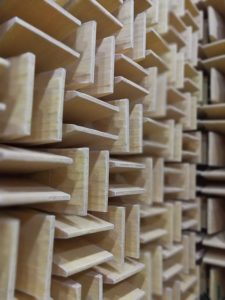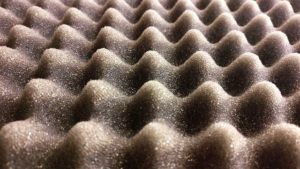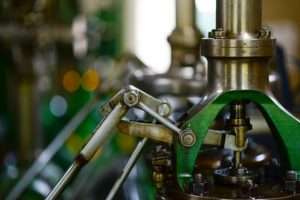American Made, Iron Clad Protected - Discover the Industries Best Warranty.
Blog
How to Design an Acoustic Enclosure in the Workspace
https://pixabay.com/photos/soundproof-room-irregular-wall-2291589/
It’s no surprise that a workspace can be every other employee’s second home. Add to that the high ceilings, spacious workspace, and concrete flooring – all that make a perfect ambiance for industrial facilities as well as office areas. But here’s the harsh reality: noise can disrupt the entire work rhythm. An acoustic enclosure comes to the rescue.
Noisy equipment may not only create voice pollution but it may also hinder the productivity of industrial workers while increasing stress levels. Likewise, coworkers indulging in conversations are likely to disturb those who are struggling to concentrate on an important project. That’s when soundproof curtains and acoustic enclosures should come into play.
Designing acoustic enclosures helps you control sound in the workspaces while providing a comfortable, noise-free environment to your employees. But lack of knowledge about how to design acoustic enclosures might enhance unwanted sound instead of eliminating it. That’s why it’s worth knowing how exactly these noise barriers should be designed so you can easily specify the requirements to the manufacturers of acoustic enclosures.
Let’s dig deeper and explore the essential information you should know before ordering acoustic enclosures for your workspace.
Know the level of sound reduction your workspace requires
Soundproof curtains or acoustic enclosures must be designed in a way that they can reduce noise below 85 decibels. That’s a standard limit if the workers have an eight-hour shift. Take it this way: if a machine produces 120 decibels of noise, you’ll require a sound enclosure that can reduce the sound of 35 decibels. This will result in an overall sound of 85 decibels (120 decibels minus 35 decibels). This level of noise is low enough to maintain a noise-friendly workspace.
An acoustic barrier will be sufficient for your workspace if the noise control requirement ranges from 5 decibels to 10 decibels. However, you’ll need a higher soundproofing option if you want a noise reduction between 35 and 55 decibels. Since calculating the exact acoustic requirement is a complicated process, an acoustic engineer will first assess your machinery, and then, guide you accordingly.
Calculate the dimensions of the acoustic enclosure
https://pixabay.com/photos/panel-acoustic-foam-sound-insulation-5213732/
The dimensions of acoustic enclosures depend on several factors. It will have limited measurements if it’s a partial enclosure. Likewise, you can expect the length, breadth, and height to be higher than expected if you want a complete enclosure.
It also depends on the size of the overall workspace. If the space is limited, the enclosure will have close proximity with your machinery, and vice versa. Whichever the case, you must ensure that there’s enough space between the enclosure and machinery for achieving optimum acoustic performance. Work on the dimensions accordingly. But it’s always better to ask an acoustic professional to avoid any confusion.
Check if all openings are insulated
Noise might escape acoustic enclosures or sound curtains if there’s any opening left. Therefore, it’s crucial to check and get it insulated beforehand. Some potential penetrations might include ventilation spaces, utilities, inlets, outlets, etc.
Identify your need to access the enclosure space
There are times when you need access to the machinery (for maintenance or other reasons). Therefore, you can specify the same to the acoustics manufacturers. If your machinery requires frequent maintenance, you’ll definitely need some access after every few days or months.
The good news is that acoustic enclosures can be custom-made according to your needs. They provide complete disassembly or partial disassembly without hindering the acoustic performance. Some other options include removable panels, liftable enclosures, sliding doors, and oversized doors. You should first identify your maintenance needs and order an enclosure accordingly.
Analyze the need for windows, doors, and removable panels
Acoustic enclosures should never be designed in a way that they restrict access to your machinery. Therefore, they should have access penetrations such as windows and doors. This helps maintain and monitor the equipment as the need arises.
The next step is to choose among the types of acoustic doors and windows. There are single doors and automatic sliding doors. You can choose the one that best fulfills your acoustic requirements. The same goes for acoustic windows. It’s wise to consult the acoustics manufacturer if you find it hard to select the perfect size.
Inquire if ventilation is the requirement inside the acoustic enclosures
It’s undeniably true that any machinery produces an excess amount of heat. Overheating can be extremely dangerous if not removed from an acoustic enclosure. It can even harm the health of your workers while putting an adverse effect on your computers and other important assets. Therefore, you should think about installing a ventilation system. Besides, it should be on your high-priority list.
Ventilation and acoustic experts will be able to guide you on this before you place the order.
Know if lighting is required inside the acoustic enclosure
Having sufficient lighting inside an acoustic enclosure will help operators run the specific machinery without any error. They might also use lights for the supervision of machinery if needed outside the enclosure. Whichever the case, you can choose either LED or fluorescent lighting to place inside the enclosure.
Choose the material wisely
https://pixabay.com/photos/machine-mill-industry-steam-2881171/
Workspaces within mining and paper industries often get exposed to high humidity, chemicals, heat, and debris that might fly over acoustic enclosures. This might decrease the longevity of enclosures. If your business relates to such industries, you should specify this to acoustic manufacturers so they can suggest related materials for your enclosure. A carefully-engineered enclosure (made of heat-resistant and dustproof materials) will last longer.
The takeaway
Nobody wants an incorrectly designed acoustic enclosure when the purpose is to block unwanted noise in the workspace. You should also remember that noise may even kill your employees’ productivity while negatively affecting your profits in the long run. So, why invest in a wrong design when you want every bit of detail to be correct while designing acoustic enclosures?
Now that you’re aware of the information required for designing the enclosure, the best bet is to get the professionals involved. Share your design criteria with them so they can further guide you. Once you’re confident about the design of your acoustic enclosure, it’s high time that you should place an order and let your employees work productively without unwanted sounds.
Recent Posts
- The Silent Safety Hero: Why Fixed Draft Curtains Are Required in High-Rack Storage Facilities
- The Invisible Risk: How Contamination Happens Without Proper Warehouse Barriers
- Are Your Insulated Warehouse Curtains Compliant
- Understanding Noise Regulations – When Is a Temporary Noise Barrier Legally Required?
- 7 Powerful Ways Industrial Curtain Walls Boost Employee Productivity
- Noise Enclosures vs. Traditional Soundproofing: Which Is Right for Your Facility?
- Steel Guard Safety Achieves SBA HUBZone Certification, Expanding Government Market Opportunities
- 5 Myths and 5 Truths about Smoke Curtains
- 7 Common Mistakes to Avoid When Setting Up Machine Guarding Fences
- Industrial Curtain Walls: 6 Reasons Why Manufacturing Facilities Must Have Them
Categories
- Accordion Fold Curtains
- Acoustic Baffles
- Agri-Shield Curtains
- Auto Body Shop Curtains
- Bio Plastics
- Draft & Smoke Curtains
- Industrial Divider Curtains
- Industrial Safety Products
- Insulated Curtain Walls
- Machine Guard Safety Fencing
- Mesh Curtain Screens
- News
- Outdoor Curtains
- PVC Strip Curtains
- Smoke & Draft Curtains
- Soundproof Noise Blocking Curtains
- Spray Paint Booth Curtains
- Tarps
- Thermal Curtains & Covers
- Uncategorized
- Warehouse Dividers
- Welding Blankets
- Welding Curtains
- Welding Screens





